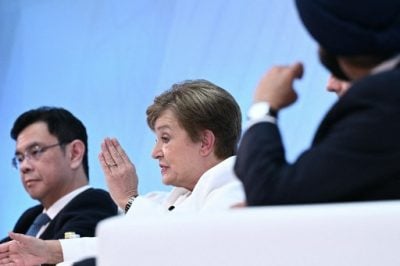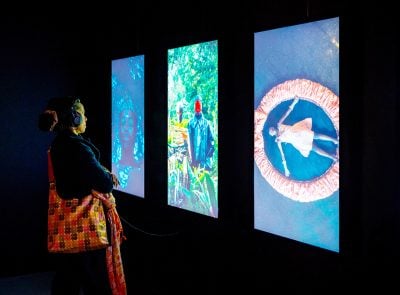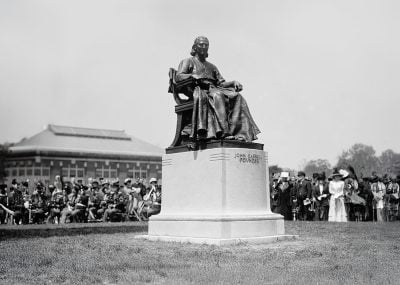Regional integration was the theme of this year’s African Development Bank summit held in Malabo, Equatorial Guinea. Intra-African trade is still only 18% of the continent’s total compared to 70% for Europe. The annual gathering discussed how this figure could be scaled up. Report by Tom Collins.
After Annual General Meetings (AGMs) in India and South Korea, the African Development Bank (AfDB) returned to Africa this year to convene its 54th annual meeting in Equatorial Guinea’s capital city of Malabo.
Under the theme of ‘Regional integration for Africa’s economic prosperity’, the four-day event brought together members of government, the private sector and development institutions to discuss harmonising cross-border interactions across the continent.
Despite 24 countries having ratified the long-awaited African Continental Free Trade Area, which will usher in a $3.3 trillion zero-tariff trade area when rolled out across the continent, the bank’s President Akinwumi Adesina kicked off the forum by illustrating the scale of work left to be done.
“In Europe regional trade amounts to 70% of the total, in Asia it is 60% and in Africa it is only 18%,” Adesina told a press conference before the official opening.
The low level of intra-African trade is a major stumbling block to Africa’s development aspirations and more must be done to retain wealth on the continent, he said.
“Apart and divided, Africa is weakened. Together and united, Africa will be unstoppable. Pulling down non-tariff barriers alone will spur trade by at least 53%, and potentially, double trade.”
In line with its strategic High 5s agenda (Light up and Power Africa; Feed Africa; Industrialise Africa; Integrate Africa and Improve the quality of life for people in Africa), the AfDB has been working to strengthen regional integration across the continent.
Up to $1bn has been invested in trade finance, together with $1bn invested in the bank’s partner, Afreximbank, which specialises in intra-African trade as an import-export bank.
According to Adesina, $630m has also been invested in two South African banks – FirstRand and Absa – in order to support the expansion of access to trade finance for 20 countries.
Digital finance initiative
On the sidelines of the meeting the bank launched the Africa Digital Financial Inclusion Facility (ADFI) together with its partners the Bill & Melinda Gates Foundation, the government of Luxembourg and the French development agency – the Agence Française de Développement (AFD)
Pierre Guislain, AfDB vice-president for private sector, infrastructure and industrialisation, said the goal is to ensure that at least 320m more Africans, of whom nearly 60% are women, have access to digital financial services.
Africa has enjoyed a surge in mobile phone ownership and internet access, which includes a suite of financial technology products. However, although rates vary drastically between countries, as well as between urban and rural demographics, it is estimated that only 43% of adults across the continent have access to a bank account.
The fund will deploy $400m by 2030 to scale up access to electronic financial services for low-income communities.
“Financial inclusion, achieved through digital financial service models, is simultaneously a powerful anti-poverty strategy and a catalyst of sustainable economic development for national and regional economies,” said Michael Wiegand, director of the Financial Services for the Poor strategy at the Bill & Melinda Gates Foundation at the launch.
The fund’s opening project and pilot for the facility is a $11.3m grant from the Gates Foundation to the AfDB and the Central Bank of West African States.
Other tangible outcomes from the meetings include $17m worth of pledges made by dignitaries to replenish the Africa Solidarity Trust Fund (ASTF), an initiative which aims to provide food security and eliminate rural poverty on the continent.
The pledges were made at a high-level donor round table convened by the United Nations Food and Agriculture Organisation (FAO) and Equatorial Guinea President Obiang Nguema Mbasogo, who said the fund was a “turning point in the fight against food insecurity.”
The fund received inaugural contributions of $30m from Equatorial Guinea and $10m from Angola and has to date mobilised funds in Malawi, Mali, Niger and Liberia.
Jennifer Blanke, AfDB vice president of agriculture, human and social development, said Africa faces challenges in the area of agriculture and food production, relying heavily on food imports.
“It’s so important that ASTF is showing that African countries are contributing to Africa. That links very closely to what we are doing,” she said.
Funding key initiatives
Out of the total $17m raised, $10m was given by Angola, $2.6m from China, €2m ($2.27m) from France, $2m from Equatorial Guinea and $100,000 from Zimbabwe. Switzerland also signed two agreements with the bank amounting to 3.2m Swiss francs ($3.7m) in order to help fund two key initiatives: the Entrepreneurship Lab (E-Lab) for innovative young entrepreneurs, and the Urban and Municipal Development Fund for Africa (UMDF), which helps African cities plan and manage urban growth and climate-resilient development by improving governance and basic services.
“These days it’s important that partners work together… to put talents together in a complementary fashion… These are two areas which are forward-leaning and positive for the African continent,” said Raymund Furrer, Bank Governor for Switzerland, who signed the agreements on the behalf of his country.
The E-Lab will run as a pilot in Côte d’Ivoire, Kenya, Ghana, Nigeria and South Africa and is expected to provide young entrepreneurs with financing, technical assistance and broader ecosystem support through incubators, accelerators and fund managers.
The initiative was launched through a partnership with the AfDB and European Investment Bank and is part of the bank’s broader strategy of creating 25m jobs by 2025.
Central Africa push
The meetings are also expected to draw dividends for Africa’s least developed region: Central Africa.
In 2018, the GDP growth rate in Central Africa doubled to 2.2% from 1.1% in 2017, but remained below the sub-Saharan average of 3.5%, with many countries suffering due to poor market access and paltry cross-border trade.
According to AfDB’s Economic Outlook for 2019, unveiled at the Malabo meetings, East Africa topped the rankings by growing 5.7% in 2018, with a predicted growth of 5.9% in 2019, and 6.1% in 2020. The report estimated growth across the continent at 4% for this year, climbing to 4.1% in 2020.
Policy recommendations, which may boost growth by up to 4.5% of total GDP, include removing bilateral tariffs, keeping rules of origin simple and transparent, removing all non-tariff barriers on goods and services and implementing the World Trade Organisation’s trade facilitation agreements.
Along with Equatorial Guinea the Central Africa region includes Angola, Cameroon, the Cental African Republic, Chad, Democratic Republic of Congo (DRC), Gabon, Republic of Congo and São Tomé and Príncipe, which together with Rwanda and Burundi make up the Economic Community of Central African States (ECCAS).
The Economic and Monetary Community of Central Africa (CEMAC) is a separate organisation which includes Cameroon, the Central African Republic, Chad, Republic of Congo and Equatorial Guinea, who share the Central African CFA franc.
The region has a low level of integration in comparison with the East African Community (EAC) and the Southern African Development Community (SADC). It is also hamstrung by a mix of ongoing security issues, most notably in eastern DRC and the Lake Chad insurgency, which is spreading instability to surrounding Chad, Cameroon and Nigeria.
Speaking at the closing ceremony Adesina described such locations as existing within “the triangle of disaster”, where unemployment, poverty and environmental degradation give rise to serious threat. “Whenever you find these three factors, you will also find instability,” he said.
He noted that the AfDB had invested $30bn in the region over the last seven years. Specific projects include leveraging Norwegian and British money for the Congo Basin Forest Fund to reduce the rate of deforestation for its surrounding 80m inhabitants, and financing a road corridor to link Brazzaville with the Central African Republic and Chad.
“This region is endowed with arable land, forest, water and abundant diversity making it easily one of the world’s leading regions for natural resources,” he commented.
Equatorial Guinea’s new finance minister, Cesar Mba Abogo, said, “It is a real privilege to host the Bank’s Annual Meetings… The Bank’s High 5s are very much in line with our development strategy between now and 2025.”
He applauded the bank’s commitment to the subregion, and said it was a great opportunity to strengthen development gains.
“The celebration of these annual assemblies is crucial and the region which will benefit the most is our subregion of Central Africa,” he said. “We are opening and promoting our subregion.”
As part of a high-level panel, Equatorial Guinea’s President Obiang was joined on stage by his Central African counterpart, DRC President Felix Tshisekedi, along with the King of Lesotho, Letsie III, and the Prime Minister of ESwatini, Ambrose Mandvulo Dlamini.
All subscribed to boosting regional integration as a means to development across the continent.
Tshisekedi, who is on a charm offensive as the new president on the block, said his country’s great power potential could help speed up the process of industrialisation and therefore integration.
“Economic growth also needs to be achieved through industrialisation, but for industrialisation to become a reality we need to have power,” he said.
“If the INGA dam site in my country were developed to its full capacity then this could be the solution for the energy problem in Africa.”
The DRC president, however, stressed that for integration through trade to succeed, there must first be peace on the continent.
Adesina to seek re-election
As well as galvanising partners to invest in Central Africa and more broadly across regional integration, Adesina used the meeting as an opportunity to lobby shareholders for an AfDB General Capital Increase and to announce his intention to run for re-election as the bank’s president in 2020.
He told reporters at the closing press ceremony that he is seeking to renew his presidency when his first term comes to an end. “I will run again to continue the work we started,” he said.
The AfDB president is elected by its board of governors who are made up of appointed representatives from the bank’s 80 member countries, with voting power proportionate to their capital subscription.
The vote takes place during the annual meeting closest to the end of the serving president’s term.
Having replaced Rwandan economist Donald Kaberuka on 1 September 2015, Adesina will seek re-election during the bank’s next annual meetings at its headquarters in Abidjan, Côte d’Ivoire.
Of the AfDB’s 54 African and 26 non-African members, Nigeria, the United States, Japan, Egypt and South Africa have the greatest share of the vote in that order. Nigeria, where Adesina formerly served as minister of agriculture and rural development, holds the greatest proportion at 9.281% of the total.
Assessing his term in office, Adesina said: “Don’t focus on what we say but focus on what we do.”
The president pointed to key metrics such as connecting 16m people to power, 70m farmers to technology and 55m people to clean water and sanitation. “These are some of the achievements but I can tell you that there are still many miles to cover,” he commented.
Maintaining the bank’s AAA rating since he joined, Adesina has added to its ability to raise, earn and spend capital. According to the latest figures released at the conference, the bank has generated $2.5bn since 2010.
Last year the bank earned $214m in income, 48% of which was reinvested back into the institution to reinforce reserves and boost business growth. In 2017, $8.8bn in loans and other assistance was disbursed for development purposes across the continent.
The bank is now pursuing its seventh capital increase, the first since the one approved in 2010 by its governors, who act as shareholders. The decision is set to be made in October during an extraordinary assembly as bank representatives argue more capital is needed to extend the bank’s services.
As a sign of good faith, Canada, which holds $4.64bn worth of AfDB shares, recently upped its commitment of callable capital, or money which can be paid to the bank on request, to $1.1bn.
With Adesina earning the moniker of the AAA president, the bank’s capital increase is expected to be approved – some predicting by as much as three times over. “I am driven by Africa so as president of the bank, I can tell you this is no chore for me; it is a labour of love and I feel truly confident when I see the trust the governors have placed in us,” he said.
Want to continue reading? Subscribe today.
You've read all your free articles for this month! Subscribe now to enjoy full access to our content.
Digital Monthly
£8.00 / month
Receive full unlimited access to our articles, opinions, podcasts and more.
Digital Yearly
£70.00 / year
Our best value offer - save £26 and gain access to all of our digital content for an entire year!
 Sign in with Google
Sign in with Google 


